Resources
 Part of the Oxford Instruments Group
Part of the Oxford Instruments Group
Expand
Collapse
 Part of the Oxford Instruments Group
Part of the Oxford Instruments Group
Here we discuss and demonstrate experiments in our OptistatDry TLEX model with top-loading, sample-in-exchange-gas experimental space. As shown here, the ability to have the sample-in-exchange-gas rather than vacuum offers a wide range of additional experimental possibilities, including those on biological samples. 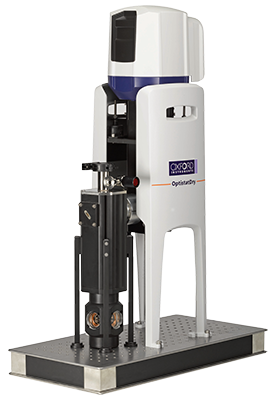
Figure 1: OptistatDry top-loading Cryofree
This application note reports a new experimental approach to measure low temperature absorbance spectra using a top-loading sample-in-exchange-gas Cryofree cryostat system, OptistatDry from Oxford Instruments (Figure 1) and a conventional UV-Vis spectrophotometer. The set-up has been used for the photolytic studies of vitamin B12, which is the largest of all vitamins and is a tetrapyrrole-based diamagnetic, six- coordinate Co(III) complex (Figure 2) that is an essential biomolecule for life.
Biologically active forms of vitamin B12 are 5'-deoxy-adenosyl-cobalamin (R= 5'-deoxy- adenosyl) and methyl-cobalamin (R= CH3), which act as essential cofactors to numerous enzymes throughout all kingdoms of life. The key to the reactivity of these vitamin B12-derivatives is the breakage of the cobalt-carbon bond upon binding of a substrate to the enzyme. This same process can also be triggered by light as the cobalt-carbon bond is light-sensitive and undergoes photolysis upon illumination [1]. The photolysis reaction can be monitored by optical spectroscopy and by studying this process at low temperatures it should be possible to detect novel photo-intermediates that are important in biology.
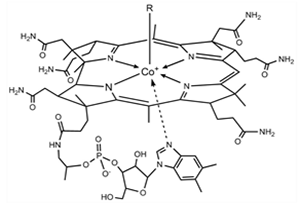
Figure 2. Molecular structure of vitamin B12
A Cary 60 UV-Vis spectrophotometer, equipped with a fibre optic coupler accessory (Agilent Technologies), was used for measuring absorbance spectra of samples in the OptistatDry cryostat. Two optical fibres were attached to the spectrophotometer for coupling the Xenon light source through the sample chamber of the cryostat and back to the detector (Figure 3). The position of the optical fibres could be fine-tuned using a precision translation mount on the input and output sides of the cryostat to optimise light-throughput and increase the signal-to-noise-ratio.
A transparent acrylic cuvette containing a 1 ml solution of methyl-cobalamin in 1,2-propanediol was placed in the sample holder and transferred to the top-loading OptistatDry cryostat, which contains four quartz windows for optical measurements. Absorbance spectra were measured at room temperature and 7 K, before and after illumination for 1 min, which was provided by an LED at 530 nm (Thorlabs) through a third window.
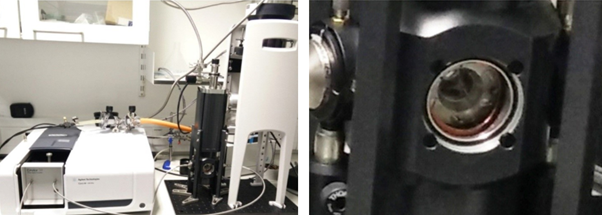
Figure 3. OptistatDry cryostat coupled to a Cary 60 UV-Vis spectrophotometer (Agilent Technologies) by optical fibres.
The UV-Vis absorption spectra of methyl-cobalamin obtained at room temperature and 7 K are shown in Figure 4. Samples that were cooled to 7 K show a sharpening of the absorbance features (Figure 4).
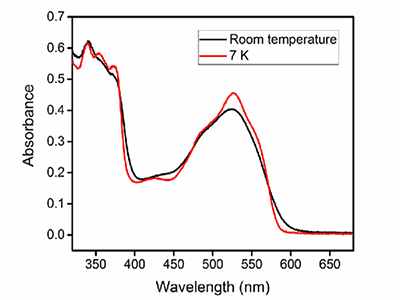
Figure 4. UV-Vis absorption spectrum of methyl- cobalamin in 1,2-propanediol at 7 K and at room temperature prior to illumination.
Upon photo-irradiation at room temperature the spectral features show a decrease in absorbance at ~530 nm and an increase at ~475 nm (Figure 5). This is indicative of the formation of a cob(II)alamin radical [2], confirming that photolysis of the Co-C bond has occurred.
This process can be followed kinetically by following the decrease in absorbance at 530 nm over time (Figure 5). However, no spectral changes were observed upon illumination at 7 K (Figures 5 and 6), which indicate that photolysis cannot occur at these temperatures.
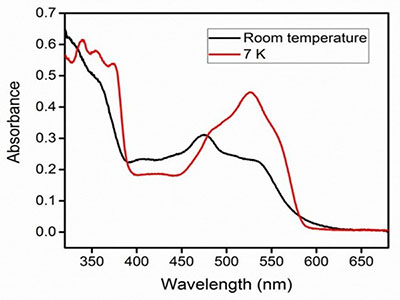
Figure 5. UV-Vis absorption spectrum of methyl-cobalamin in 1,2-propanediol at 7 K and at room temperature after illumination with an LED at 532 nm.
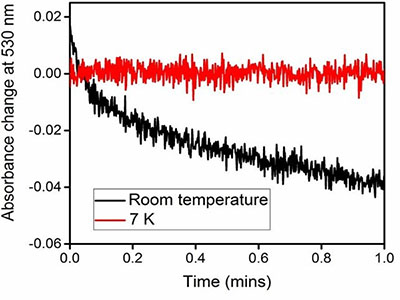
Figure 6. Absorbance change at 530 nm upon illumination of methyl-cobalamin in 1,2-propanediol with an LED at 532 nm at 7 K and at room temperature.
Absorption spectra of vitamin B12 were successfully recorded at 7 K and room temperature using the OptistatDry cryostat. Direct illumination was possible via a 3rd optical window, allowing the measurement of light-activated reactions. The signal-to-noise and stability over long time periods show that the compressor has no adverse effect on these measurements. This paves the way for further low temperature photolysis measurements of vitamin B12 at a range of cryogenic temperatures.
The OptistatDry provides a temperature-controlled sample measurement environment within a Cryofree cryostat. It offers a range of top and bottom loading compact cryostats with optical access cooled by a closed cycle refrigerator. The system is capable of cooling samples to helium temperatures without the need for liquid cryogens. This provides significant benefits in terms of ease of use and running costs. The system enables optical measurements to be carried out on your samples, as shown in this application note.
The Manchester Interdisciplinary Biocentre was completed in 2006 and represented the first university-based, purpose-built interdisciplinary research institute of its kind in the UK. Focusing on advanced quantitative approaches to specific biotechnology challenges at the interface between medicine and biology and the physical sciences, engineering, mathematics, and computation the MIB enjoys a unique pluralistic and open research culture that is supported by world-class infrastructure. The establishment of multi-skilled interdisciplinary teams with critical mass generates unique capabilities that cannot be realised through virtual associations between PIs or research units to develop regional, national, and international partnerships in biotechnology research.
[1] A.R. Jones et al., Relating localized protein motions to the reaction coordinate in coenzyme B12-dependent enzymes. FEBS J., 2013, 280, 2997-3008.
[2] A.G. Cole et al., Time-resolved spectroscopic studies of B12 coenzymes: a comparison of the primary photolysis mechanism in methyl-, ethyl-, n-propyl-, and 5’-deoxyadenosylcobalamin. Journal of the American Chemical Society. 2002, 124.3, 443-441.
Date: August 2022
Author: Simon Mitchinson, (Oxford Instruments) Lara Grangel, Samantha J. O. Hardman and Derren J. Heyes Manchester Institute of Biotechnology, University of Manchester, UK
Category: Application Note
